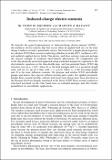Induced-charge electro-osmosis
Author(s)
Squires, Todd M.; Bazant, Martin Z.
DownloadBazant_2004_Induced.pdf (520.9Kb)
Terms of use
Metadata
Show full item recordAbstract
We describe the general phenomenon of ‘induced-charge electro-osmosis’ (ICEO) –
the nonlinear electro-osmotic slip that occurs when an applied field acts on the ionic
charge it induces around a polarizable surface. Motivated by a simple physical picture,
we calculate ICEO flows around conducting cylinders in steady (DC), oscillatory (AC),
and suddenly applied electric fields. This picture, and these systems, represent perhaps
the clearest example of nonlinear electrokinetic phenomena. We complement and
verify this physically motivated approach using a matched asymptotic expansion to the
electrokinetic equations in the thin-double-layer and low-potential limits. ICEO slip
velocities vary as u_s ∠E_0^2
L, where E_0 is the field strength and L is a geometric length
scale, and are set up on a time scale τc =λDL/D, where λD is the screening length
and D is the ionic diffusion constant. We propose and analyse ICEO microfluidic
pumps and mixers that operate without moving parts under low applied potentials.
Similar flows around metallic colloids with fixed total charge have been described in
the Russian literature (largely unnoticed in the West). ICEO flows around conductors
with fixed potential, on the other hand, have no colloidal analogue and offer further
possibilities for microfluidic applications.
Date issued
2004Department
Massachusetts Institute of Technology. Department of Chemical EngineeringPublisher
Cambridge University Press
Citation
Journal of Fluid Mechanics 509, p.217-252 (2004)
Keywords
induced-charge, electro-osmosis